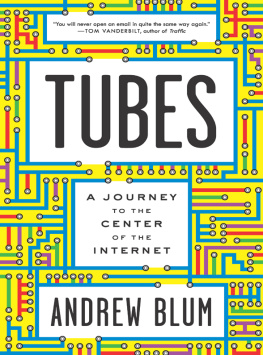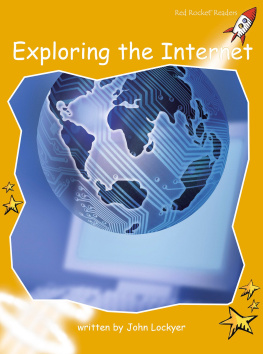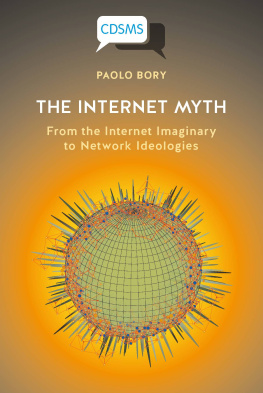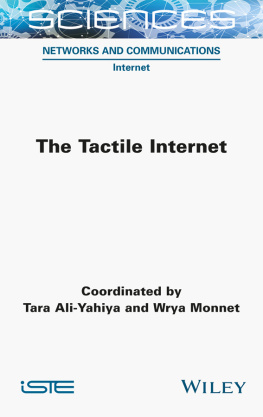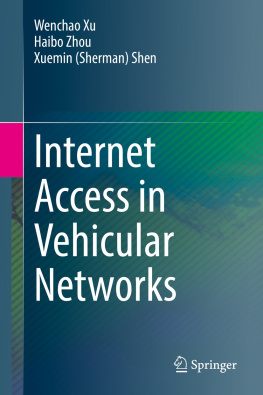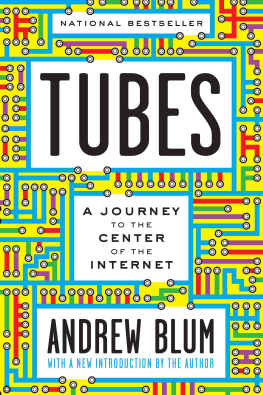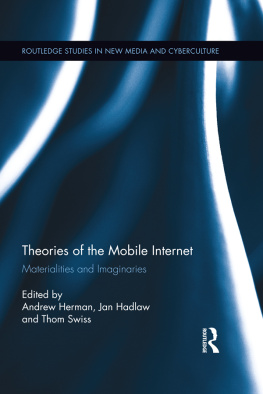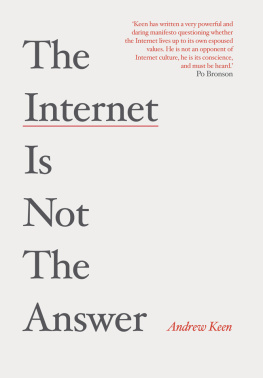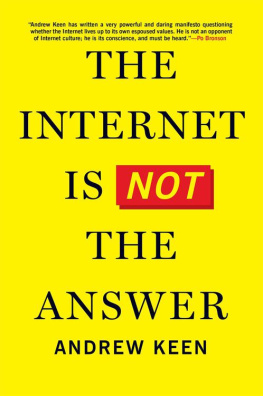TUBES

A JOURNEY
TO THE
CENTER
OF THE
INTERNET

ANDREW BLUM

For Davina and Phoebe
It is not down in any map; true places never are.
HERMAN MELVILLE
Somehow I knew that the notional space behind all of the computer screens would be one single universe.
WILLIAM GIBSON
Contents
On a bitterly cold day a few winters ago, the Internet stopped working. Not the whole Internet, only the section that resides in a dusty clump beside my living room couch. Theres a black cable modem with five green lights, a blue telephone adapter the size of a hardcover book, and a white wireless router with a single illuminated eye. On good days they all blink happily at one another, satisfied with the signals coming through the wall. But on that day their blinking was labored. Web pages loaded in fits and starts, and my phoneof the voice over IP variety, which sends calls over the Internetmade everyone sound like a scuba diver. If there were little men inside these boxes, then it was as if they had suddenly become prone to naps. The switch itself had fallen asleep.
The repairman arrived the next morning, full of assurances. He attached an electronic whistleit looked like a penlightto the living room end of the cable, and then began to trace its path, searching for clues. I followed him, first outside to the street, then down into the basement and through a hatch to the backyard. A rusty switch box was caught in a web of black cables and bolted to a brick wall. Disconnecting them one at a time, he screwed a tiny speaker into each one until he found the one that whistled: audible proof of a continuous path between here and there.
Then his eyes lifted ominously to the sky. A squirrel scampered along a wire toward a battleship gray enclosure affixed like a birdhouse to a pole. Anemic urban vines wrapped around it. Animals chew on the rubber coating, the repairman explained. Short of rewiring the whole backyard there was nothing he could do. But it might get better on its own, he said, and it did. But the crude physicality of the situation astonished me. Here was the Internet, the most powerful information network ever conceived! Capable of instantaneous communication with anyplace on earth! Instigator of revolutions! Constant companion, messenger of love, fountain of riches and beloved distraction. Stymied by the buckteeth of a Brooklyn squirrel.
I like gadgets. I will happily discuss the Internet as a culture and a medium. My mother-in-law calls me for tech support. But I confess that the substance of the thinga thing that squirrels can nibble athad escaped me. I may have been plugged in, but the tangible realities of the plug were a mystery to me. The green lights on the box in my living room signaled that the Interneta singular unnuanced wholewas, to put it simply, on. I was connected, yes; but connected to what? Id read a few articles about big factory-sized data centers filled with hard drives, invariably someplace far away. Id unplugged and plugged back in my share of broken cable modems behind the couch. But beyond that, my map of the Internet was blankas blank as the Ocean Sea was to Columbus.
That disconnect, if I can use that word, startled me. The Internet is the single biggest technological construction of our daily existence. It is vivid and alive on the screens all around us, as boisterous as a bustling human city. Two billion people use the Internet, in some form, every day. Yet physically speaking, it is utterly disembodied, a featureless expanse: all ether, no net. My Lost City, the protagonist climbs to the top of the Empire State Building and recognizes, crestfallen, that his city had limits. And with the awful realization that New York was a city after all and not a universe, the whole shining edifice that he had reared in his imagination came crashing to the ground. I realized that my Internet had limits too. Yet, oddly, they werent abstract limits but physical ones. My Internet was in piecesliterally. It had parts and places. It was even more like a city than I had thought.
The squirrel outage was annoying, but the sudden appearance of the Internets texture was thrilling. Ive always been acutely attuned to my immediate surroundings, to the world around me. I tend to remember places the way a musician does tunes or a chef, flavors. Its not merely that I like to travel (although I do), but more that the physical world is a source of constant, sometimes overwhelming, preoccupation. I have a strong sense of place, as some people describe it. I like to notice the widths of the sidewalks in cities and the quality of light in different latitudes. My memories are almost always keyed to specific places. As a writer, thats often led me to the subject of architecture, but its never been the buildings themselves that interest me most, rather the places the buildings createthe sum total of construction, culture, and memory; the world we inhabit.
But the Internet has always been a necessary exception to this habit, a special case. Sitting at my desk in front of a computer screen all day, and then getting up at the end of the day and habitually looking at the other, smaller screen I carry in my pocket, I accepted that the world inside them was distinct from the sensory world all around meas if the screens glass were not transparent but opaque, a solid border between dimensions. To be online was to be disembodied, reduced to eyes and fingertips. There wasnt much to do about it. There was the virtual world and the physical world, cyberspace and real places, and never the two shall meet.
But as if in a fairy tale, the squirrel cracked open the door to a previously invisible realm behind the screen, a world of wires and the spaces in between. The chewed cable suggested that there could be a way of stitching the Internet and the real world together again into a single place. What if the Internet wasnt an invisible elsewhere, but actually a somewhere? Because this much I knew: the wire in the backyard led to another wire, and another behind thatbeyond to a whole world of wires. The Internet wasnt actually a cloud; only a willful delusion could convince anyone of that. Nor was it substantially wireless. The Internet couldnt just be everywhere. But then where was it? If I followed the wire, where would it lead? What would that place look like? Who would I find? Why were they there? I decided to visit the Internet.
When in 2006 over the senators cluelessness. Late-night comics showed side-by-side pictures of dump trucks and steel tubes. DJs mixed mash-ups of his speech. I made fun of him to my wife.
Yet I have now spent the better part of two years on the trail of the Internets physical infrastructure, following that wire from the backyard. I have confirmed with my own eyes that the Internet is many things, in many places. But one thing it most certainly is, nearly everywhere, is, in fact, a series of tubes. There are tubes beneath the ocean that connect London and New York. Tubes that connect Google and Facebook. There are buildings filled with tubes, and hundreds of thousands of miles of roads and railroad tracks, beside which lie buried tubes. Everything you do online travels through a tube. Inside those tubes (by and large) are glass fibers. Inside those fibers is light. Encoded in that light is, increasingly,

